CCS Risk Assessment: Groundwater Contamination Caused by CO2
Abstract
:1. Introduction
- -
- to present a framework and a numerical simulator that have been developed at the University of Ottawa to predict and assess the potential consequences of CO2 leakage on the quality of UDW;
- -
- to provide an overview of the potential alterations in UDW quality caused by CO2 and drinking-water quality guidelines (which are relevant for groundwater contamination caused by CO2) that exist in Canada and other countries; and
- -
- to present an example of the application of the developed simulator to assess the consequences of CO2 leakage on the quality of groundwater located in a Canadian CO2 storage site.
2. Developed Framework
- (i)
- an understanding and the identification of all potential mechanisms and processes of UDW quality alteration caused by CO2 disposal and/or leakage. Figure 2 depicts the potential mechanisms and processes of UDW alteration by unanticipated leakage and/or migration of CO2;
- (ii)
- the identification of UDW guidelines or standards (which describe the quality parameters set for drinking water) that apply to the CO2 injection site or region. Table 1 shows current worldwide guidelines for drinking water quality in terms of the chemical parameters (relevant to CCS), and Table 2 shows the Canadian guidelines for the main chemical and physical parameters. These guidelines establish the maximum acceptable concentrations (MACs) of various chemical substances in drinking water. The WHO guidelines are used as the basis for regulation and the setting of standards in many countries.
- (iii)
- the identification and development of all potential CO2 leakage scenarios by using an appropriate modeling tool and approach. Models that apply numerical, analytical, and semianalytical solution methods have been successfully used to simulate the injection of CO2 into subsurface formations, the reactive transport of CO2 and potential leakage scenarios (e.g., References [14,15,16,17,18,19,20,21,22,23,24,25,26,27,28,29,30,31,32]);
- (iv)
- the modeling and prediction of the impact of leaked CO2 on the quality of UDW for each leakage scenario previously identified by using a thermo-hydro-mechanical-chemical (THMC) simulator developed in this study (Section 3). This modeling allows evaluating the evolution of the quality or chemical composition and characteristics of the UDW in response to the intrusion of CO2;
- (v)
- (vi)
- a selection of appropriate techniques for groundwater contamination mitigation (e.g., Reference [33]) if the changes in the UDW quality induced by CO2 intrusion are judged as inacceptable;
- (vii)
- the modeling and prediction of the impact of selected mitigation techniques on the improvement in UDW quality by using the THMC simulator. The predicted chemical parameters of the remediated groundwater are then compared with those set by the selected drinking-water quality guidelines to evaluate its acceptability.
3. THMC Tool for Modeling Consequences of CO2 Leakage on UDW Quality
3.1. Introduction
3.2. Simulator Structure and Couplings
3.3. Description of the THMC Model
3.3.1. Governing Equations and Constitutive Functions for the THC Model
3.3.2. Governing Equations and Constitutive Functions in FLAC3DDM
3.4. Simulator Validation
3.4.1. First Validation Example
3.4.2. Second Validation Example
3.4.3. Third Validation Example
4. Application to Potential Canadian CO2 Disposal Sites
4.1. Introduction
4.2. Site Description
4.3. Model Setup
4.4. Initial and Boundary Conditions
4.5. Examples of Results and Discussions
4.5.1. Spatial Distribution and CO2 Evolution
4.5.2. Changes in Groundwater Acidity
4.5.3. Prediction of Heavy-Metal Concentrations
5. Summary and Conclusions
Author Contributions
Funding
Conflicts of Interest
References
- WMO, Working Group I. Climate Change 2001: The Scientific Basis; Technical Report; Cambridge University Press: Cambridge, UK, 2001; p. 94. [Google Scholar]
- Pearson, D. The Potential Impact of Climate Change on the Mining Industry in Canada. In Proceedings of the Mining and Environment, Sudbury, ON, Canada, 25–28 May 2003; p. 12. [Google Scholar]
- Intergovernmental Panel on Climate Change (IPCC). Climate Change 2014—The Synthesis Report of the Fifth Assessment Report of the Intergovernmental Panel on Climate Change; The Core Writing Team, Pachauri, R.K., Meyer, L., Eds.; Intergovernmental Panel on Climate Change: Geneva, Switzerland, 2014; p. 139.
- Solomon, S. Carbon Dioxide Storage: Geological Security and Environmental Issues—Case Study on the Sleipner Gas Field in Norway. Bellona Report. 2007. Available online: https://network.bellona.org/content/uploads/sites/3/Case_Study_on_the_Sleipner_Gas_Field_in_Norway.pdf (accessed on 24 October 2018).
- Shaffer, G. Long-term effectiveness and consequences of carbon dioxide sequestration. Nat. Geosci. 2010, 3, 464–467. [Google Scholar] [CrossRef]
- Alonso, J.; Navarro, V.; Calvo, B.; Asensio, L. Hydro-mechanical analysis of CO2 storage in porous rocks using a critical state model. Int. J. Rock Mech. Min. Sci. 2012, 54, 19–26. [Google Scholar] [CrossRef]
- Porter, M.L.; Plampin, M.; Pawar, R.; Illangasekare, T. CO2 leakage in shallow aquifers: A benchmark modeling study of CO2 gas evolution in heterogeneous porous media. Int. J. Greenh. Gas Control 2015, 39, 51–61. [Google Scholar] [CrossRef]
- Yang, C.; Dai, Z.; Romanak, K.D.; Hovorka, S.D.; Treviño, R.H. Inverse Modeling of Water-Rock-CO2 Batch Experiments: Potential Impacts on Groundwater Resources at Carbon Sequestration Sites. Environ. Sci. Technol. 2014, 48, 2798–2806. [Google Scholar] [CrossRef] [PubMed]
- Bacon, D.H.; Qafoku, N.P.; Dai, Z.; Brown, C.F. Modeling the impact of carbon dioxide leakage into an unconfined, oxidizing carbonate aquifer. Int. J. Greenh. Gas Control 2016, 44, 190–299. [Google Scholar] [CrossRef]
- Birkholzer, J.; Daley, T.; Jordan, P.; Oldenburg, C.; Rutqvist, J. National Risk Assessment Partnership (NRAP). 2011. Available online: http://esd.lbl.gov/research/programs/gcs/projects/nrap/ (accessed on 24 October 2018).
- Apps, J.A.; Zheng, L.; Zhang, Y.; Xu, T. Evaluation of potential changes in groundwater quality in response to CO2 leakage from deep geologic storage. Transp. Porous Media 2010, 82, 215–246. [Google Scholar] [CrossRef]
- Wainwright, H.; Finsterle, S.; Zhou, Q.; Birkholzer, J.T. Modeling the Performance of Large-Scale CO2 Storage Systems: A Comparison of Different Sensitivity Analysis Methods. Int. J. Greenh. Gas Control 2013, 17, 189–205. [Google Scholar] [CrossRef]
- Kharaka, Y.K.; Thordsen, J.J.; Kakouros, E.; Ambats, G.; Herkelrath, W.N.; Beers, S.R.; Birkholzer, J.T.; Apps, J.A.; Spycher, N.F.; Zheng, L.; et al. Changes in the Chemistry of Shallow Groundwater Related to the 2008 Injection of CO2 at the ZERT Field Site, Bozeman, Montana. Environ. Earth Sci. 2010, 60, 273–284. [Google Scholar] [CrossRef]
- Gunter, W.D.; Perkins, E.H.; Hutcheon, I. Aquifer disposal of acid gases: modeling of water-rock reactions for trapping of acid wastes. Appl. Geochem. 2000, 15, 1085–1095. [Google Scholar] [CrossRef]
- Rutqvist, J.; Tsang, C.F. A study of caprock hydromechanical changes associated with CO2-injection into a brine formation. Environ. Geol. 2002, 42, 296–305. [Google Scholar] [CrossRef]
- Azaroual, M.; Kervevan, C.; Durance, M.V.; Durst, P. SCALE2000: A reaction-transport software dedicated to thermo-kinetic prediction and quantification of scales. Applicability to desalination problems. Desalination 2004, 156, 409–419. [Google Scholar] [CrossRef]
- Johnson, J.W.; Nitao, J.J.; Steefel, C.; Knaus, K.G. Reactive transport modeling of geological CO2 sequestration in saline aquifers; the influence of intra-aquifer shales and the relative effectiveness of structural, solubility, and mineral trapping during prograde and retrograde sequestration. In Proceedings of the First Annual Conference on Carbon Sequestration, Washington, DC, USA, 14–17 May 2001. [Google Scholar]
- Johnson, J.W.; Nitao, J.J.; Knauss, K.G. Reactive transport modeling of CO2 storage in saline aquifers to elucidate fundamental processes, trapping mechanisms, and sequestration partitioning. In Geologic Storage of Carbon Dioxide; Special Publication 233; Baines, S.J., Worden, R.H., Eds.; Geological Society: London, UK, 2004; pp. 107–128. [Google Scholar]
- Knauss, K.G.; Johnson, J.W.; Steefel, C.I. Evaluation of the impact of CO2, co-contaminant gas, aqueous fluid, and reservoir rock interactions on the geologic sequestration of CO2. Chem. Geol. 2005, 217, 339–350. [Google Scholar] [CrossRef]
- Gaus, I.; Azarouai, M.; Czernichowski, L. Reactive transport modeling of the impact of CO2 injection on the clayey cap rock at Sleipner (North Sea). Chem. Geol. 2005, 217, 319–337. [Google Scholar] [CrossRef]
- André, L.; Audigane, P.; Azaroual, M.; Menjoz, A. Numerical modeling of fluid-rock chemical interactions at the supercritical CO2–liquid interface during supercritical CO2 injection into a carbonate reservoir, the Dogger aquifer (Paris Basin, France). Energy Convers. Manag. 2007, 48, 1782–1797. [Google Scholar] [CrossRef]
- Audigane, P.; Gaus, I.; Czernichowski-Lauriol, I.; Pruess, K.; Xu, T. Two dimensional reactive transport modeling of CO2 injection in a saline aquifer at the Sleipner site, North Sea. Am. J. Sci. 2007, 307, 974–1008. [Google Scholar] [CrossRef]
- Chang, K.W.; Minkoff, S.E.; Bryant, S.L. Modeling leakage through faults of CO2 stored in an aquifer. In Proceedings of the SPE Annual Technical Conference and Exhibition, Denver, CO, USA, 21–24 September 2008. [Google Scholar]
- Viswanathan, H.; Pawar, R.J.; Staufer, P.H.; Kaszuba, J.P.; Carey, J.W.; Olsen, S.C.; Keating, G.N.; Kevetski, D.; Guthrie, G.D. Development of a hybrid process and system model for the assessment of wellbore leakage at a geologic CO2 sequestration site. Environ. Sci. Technol. 2008, 42, 7280–7286. [Google Scholar] [CrossRef] [PubMed]
- Davis, J.P.; Davis, D.K. Stress-dependent permeability: Characterization and modeling. Soc. Petrol. Eng. 1999, 6, 224–235. [Google Scholar]
- Kolditz, O.; Bauer, S.; Bilke, L.; Böttcher, N.; Delfs, J.O.; Fischer, T.; Görke, U.J.; Kalbacher, T.; Kosakowski, G.; McDermott, C.I.; et al. OpenGeoSys: An open-source initiative for numerical simulation of thermo-hydro-mechanical/chemical (THM/C) processes in porous media. Environ. Earth Sci. 2012, 67, 589–599. [Google Scholar] [CrossRef]
- Shevalier, M.; Nightingale, M.; Mayer, B.; Hutcheon, I. TOUGHREACT modeling of the fate of CO2 injected into a H2S containing saline aquifer: The example of the Wabamum Area Sequestration Project (WASP). Energy Procedia 2011, 4, 4403–4410. [Google Scholar] [CrossRef]
- Spycher, N.; Pruess, K. A model for thermophysical properties of CO2-brine mixtures at elevated temperatures and pressures. In Proceedings of the Thirty-Sixth Workshop on Geothermal Reservoir Engineering, Stanford University, Stanford, CA, USA, 31 January–2 February 2011. [Google Scholar]
- Nogues, J.P.; Fitts, J.P.; Celia, M.A.; Peters, C.A. Permeability evolution due to dissolution and precipitation of carbonates using reactive transport modeling in pore networks. Water Resour. Res. 2013, 49, 6006–6021. [Google Scholar] [CrossRef] [Green Version]
- Nasir, O.; Fall, M.; Evgin, E. A Simulator for Modeling of Porosity and Permeability Changes in Near Field Sedimentary Host Rocks under Climate Changes Influences. Tunn. Undergr. Space Technol. 2014, 42, 122–135. [Google Scholar] [CrossRef]
- Ladubec, C.; Gracie, R.; Craig, J. An XFEM Model for Carbon Sequestration. Int. J. Numer. Methods Eng. 2014. [CrossRef]
- Yang, C.; Hovorka, S.D.; Young, M.H.; Trevino, R. Geochemical sensitivity to CO2 leakage: Detection in potable aquifers at carbon sequestration sites. Greenh. Gases Sci. Technol. 2014, 4, 384–399. [Google Scholar] [CrossRef]
- Benson, S.M.; Myer, L. Monitoring to ensure safe and effective geologic sequestration of carbon dioxide. In Proceedings of the Intergovernmental Panel on Climate Change (IPCC) Workshop on Carbon Sequestration, Regina, SK, Canada, 18–22 November 2002. [Google Scholar]
- Gaus, I. Role and impact of CO2-rock interactions during CO2 storage in sedimentary rocks. Int. J. Greenh. Gas Control 2010, 4, 73–89. [Google Scholar] [CrossRef]
- Rutqvist, J. Status of the TOUGH-FLAC simulator and recent applications related to coupled fluid flow and crustal deformations. Comput. Geosci. 2011, 37, 739–750. [Google Scholar] [CrossRef] [Green Version]
- Li, Z.; Fall, M. Coupled Thermo-Hydro-Mechanical-Geochemical Model for the Assessment of Groundwater Quality due to Impacts from Geological Sequestration of CO2. In Proceedings of the 66th Canadian Geotechnical Conference (CGC), Montreal, QC, Canada, 29 September–3 October 2013. [Google Scholar]
- Li, Z.; Fall, M. A modeling tool for assessment of potential groundwater contamination in response to CO2 leakage from geological disposal of CO2. In Proceedings of the 3rd Climate Change Technology Conference, Montreal, QC, Canada, 27–29 May 2013. [Google Scholar]
- ITASCA. Flac3D: Fast Lagrangian Analysis of Continua in 3 Dimensions; ITASCA Consulting Group Inc.: Minneapolis, MN, USA, 2009. [Google Scholar]
- Xu, T.; Spycher, N.; Sonnenthal, E.; Zheng, L.; Pruess, K. TOUGHREACT User’s Guide: A Simulation Program for Non-Isothermal Multiphase Reactive Transport in Variably Saturated Geologic Media, Version 2.0; Lawrence Berkeley National Laboratory: Berkeley, CA, USA, 2012.
- Xu, T.; Pruess, K. Modeling multiphase non-isothermal fluid flow and reactive geochemical transport in variably saturated fractured rocks: 1Methodology. Am. J. Sci. 2001, 301, 16–33. [Google Scholar] [CrossRef]
- Yu, Z.; Liu, L.; Yang, S.; Li, S.; Yang, Y. An experimental study of CO2–brine–rock interaction at in situ pressure–temperature reservoir conditions. Chem. Geol. 2012, 326–327, 88–101. [Google Scholar] [CrossRef]
- Xu, X.; Song, C.; Miller, B.G.; Scaroni, A.W. Adsorption separation of carbon dioxide from flue gas of natural gas-fired boiler by a novel nanoporous “molecular basket” adsorbent. Fuel Process. Technol. 2005, 86, 1457–1472. [Google Scholar] [CrossRef]
- Tsang, C.-F.; Birkholzer, J.; Rutqvist, J. A comparative review of hydrologic issues involved in geologic storage of CO2 and injection disposal of liquid waste. Environ. Geol. 2008, 54, 1723–1737. [Google Scholar] [CrossRef]
- Kachanov, L.M. Time of the rupture process under creep conditions. Isv. Akad. Nauk. SSR. Otd Tekh. Nauk. 1958, 8, 26–31. [Google Scholar]
- Lemaitre, J. Evaluation and dissipation of damage in metals submitted to dynamic loading. In Proceedings of the I.C.M.I., Kyoto, Japan, 1971. [Google Scholar]
- Lemaitre, J.; Chaboche, J.L. Mechanics of Materials; Cambridge University Press: Cambridge, UK, 1990. [Google Scholar]
- Hildenbrand, A.; Schlömer, S.; Krooss, B.M. Gas breakthrough experiments on fine-grained sedimentary rocks. Geofluids 2002, 2, 3–23. [Google Scholar] [CrossRef]
- Popp, T.; Salzer, K.; Minkley, W. Influence of bedding planes to EDZ-evolution and the coupled HM properties of Opalinus Clay. Phys. Chem. Earth Parts A/B/C 2008, 33, 374–387. [Google Scholar] [CrossRef]
- Popp, T.; Salzer, K. Anisotropy of seismic and mechanical properties of Opalinus clay during triaxial deformation in a multi-anvil apparatus. Phys. Chem. Earth Parts A/B/C 2007, 32, 879–888. [Google Scholar] [CrossRef]
- Stantec, C.I. Quest Carbon Capture and Storage Project; Project Description Shell Canada Limited: Calgary, AB, Canada, 2010; Volume 1. [Google Scholar]
- ERCB. Bulletin 2007-10: Alberta’s Base of Groundwater Protection (BGWP) Information; Energy Resources Conservation Board: Edmonton, AB, Canada, 2007.
- Shell Application for Quest Carbon Capture and Storage—Groundwater Review; NE 19-059-20 W4M Hydrogeological Consultants Ltd. Prepared for Ackroyd LLP; Hydrogeological Consultants Ltd.: Edmonton, AB, Canada, 2012; p. 12.
- Bachu, S.; Michael, K. Hydrogeology and Stress Regime of the Upper Cretaceous-Tertiary Coal-Bearing Strata in Alberta; Alberta Energy and Utilities Board, Alberta Geological Survey: Edmonton, AB, Canada, 2002. [Google Scholar]
- Bachu, S.; Brulotte, M.; Grobe, M.; Stewart, S. Suitability of the Alberta Subsurface for Carbon-Dioxide Sequestration in Geological Media; Report Earth Sciences Report 00-11; Alberta Energy and Utilities Board, Alberta Geological Survey: Edmonton, AB, Canada, 2000. [Google Scholar]
- Bachu, S.; Buschkuehle, M.; Haug, K.; Michael, K. Subsurface Characterization of the Edmonton-Area Acid-Gas Injection Operations; Energy Resources Conservation Board, Alberta Geological Survey: Edmonton, AB, Canada, 2008.
- Birkholzer, J.T.; Zhou, Q.; Tsang, C.F. Large-scale impact of CO2 storage in deep saline aquifers: A sensitivity study on the pressure response in stratified systems. Int. J. Greenh. Gas Control 2009, 3, 181–194. [Google Scholar] [CrossRef]
- Birkholzer, J.T.; Zhou, Q. Basin-scale hydrogeologic impacts of CO2 storage: Capacity and regulatory implications. Int. J. Greenh. Gas Control 2009, 3, 745–756. [Google Scholar] [CrossRef]
- Hitchon, B. Geochemical Studies–3 Ceochemistry of Some Alberta Shales and Associated Kerogen; Alberta Geological Survey: Edmonton, AB, Canada, 1993. [Google Scholar]
- Lemay, T.G. Chemical and Physical Hydrogeology of Coal, Mixed Coal-Sandstone and Sandstone Aquifers from Coal-Bearing Formations in the Alberta Plains Region, Alberta; Alberta Energy and Utilities Board, Alberta Geological Survey: Edmonton, AB, Canada, 2003. [Google Scholar]
- Lemay, T.G.; Konhauser, K.O. Water Chemistry of Coalbed Methane Reservoirs; Alberta Energy and Utilities Board: Edmonton, AB, Canada, 2006. [Google Scholar]
- Davies, P.B. Evaluation of the Role of Threshold Pressure in Controlling Flow of Waste-Generated Gas into Bedded Salt at the Waste Isolation Pilot Plant (WIPP); Report SAND 90-3246; Sandia National Laboratory: Albuquerque, NM, USA; Livermore, CA, USA, 1991.
- Eberth, D.; Hamblin, A. Tectonic, stratigraphic, and sedimentologic significance of a regional discontinuity in the upper Judith River Group (Belly River wedge) of southern Alberta, Saskatchewan, and Northern Montana. Can. J. Earth Sci. 1993, 30, 174–200. [Google Scholar] [CrossRef]
- Lerbekmo, J.F. Petrology of the belly river formation, southern Alberta foothills. Sedimentology 1963, 2, 54–86. [Google Scholar] [CrossRef]
- Paulen, R.C.; Paradis, S.; Plouffe, A.; Smith, I.R. Pb and S isotopic composition of indicator minerals in glacial sediments from NW Alberta, Canada: Implications for Zn-Pb base metal exploration. Geochem. Explor. Environ. Anal. 2011, 11, 309–320. [Google Scholar] [CrossRef]
- Longstaffe, F.J.; Ayalon, A. Oxygen Isotope Studies of Diagenesis and Pore-Water Evolution in the Western Canada Sedimentary Basin: Evidence from the Upper Cretaceous Basal Belly River Sandstone, Alberta. J. Sediment. Res. 1991, 58, 489–505. [Google Scholar]
- Cheung, K.; Mayer, B. Chemical and Isotopic Characterization of Shallow Groundwater from Selected Monitoring Wells in Alberta: Part I: 2006–2007; Alberta Environment: Edmonton, AB, Canada, 2009. [Google Scholar]

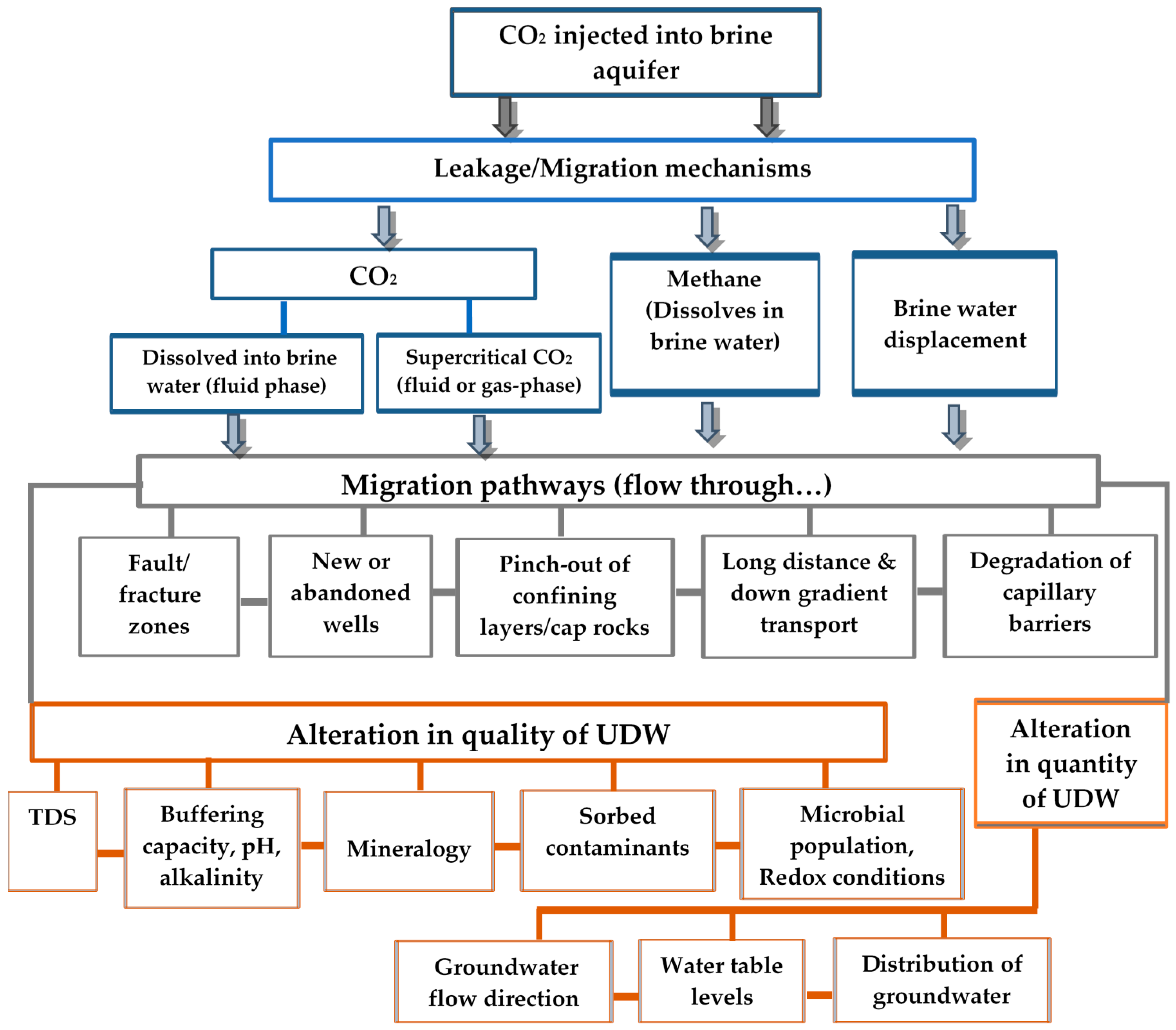
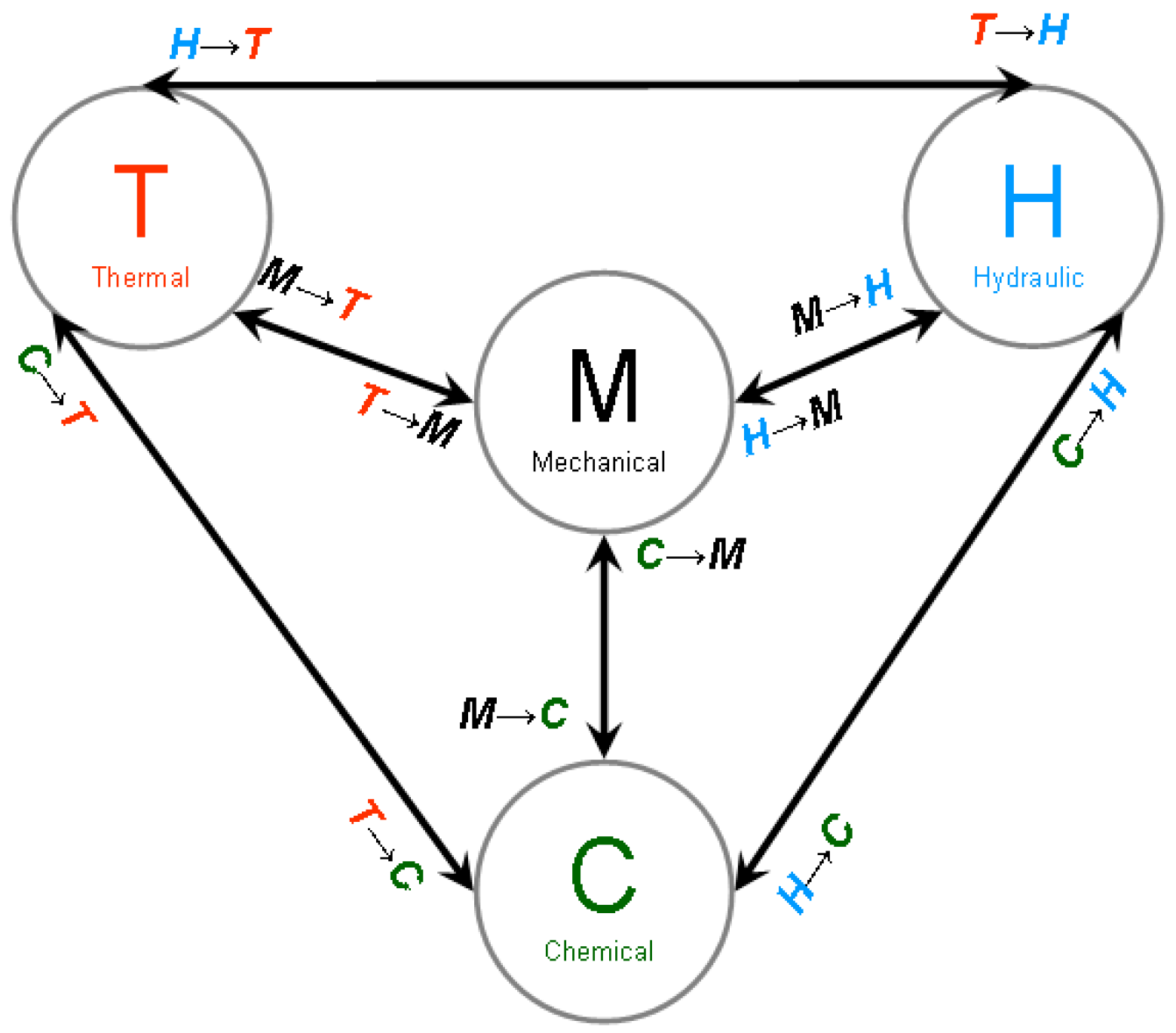

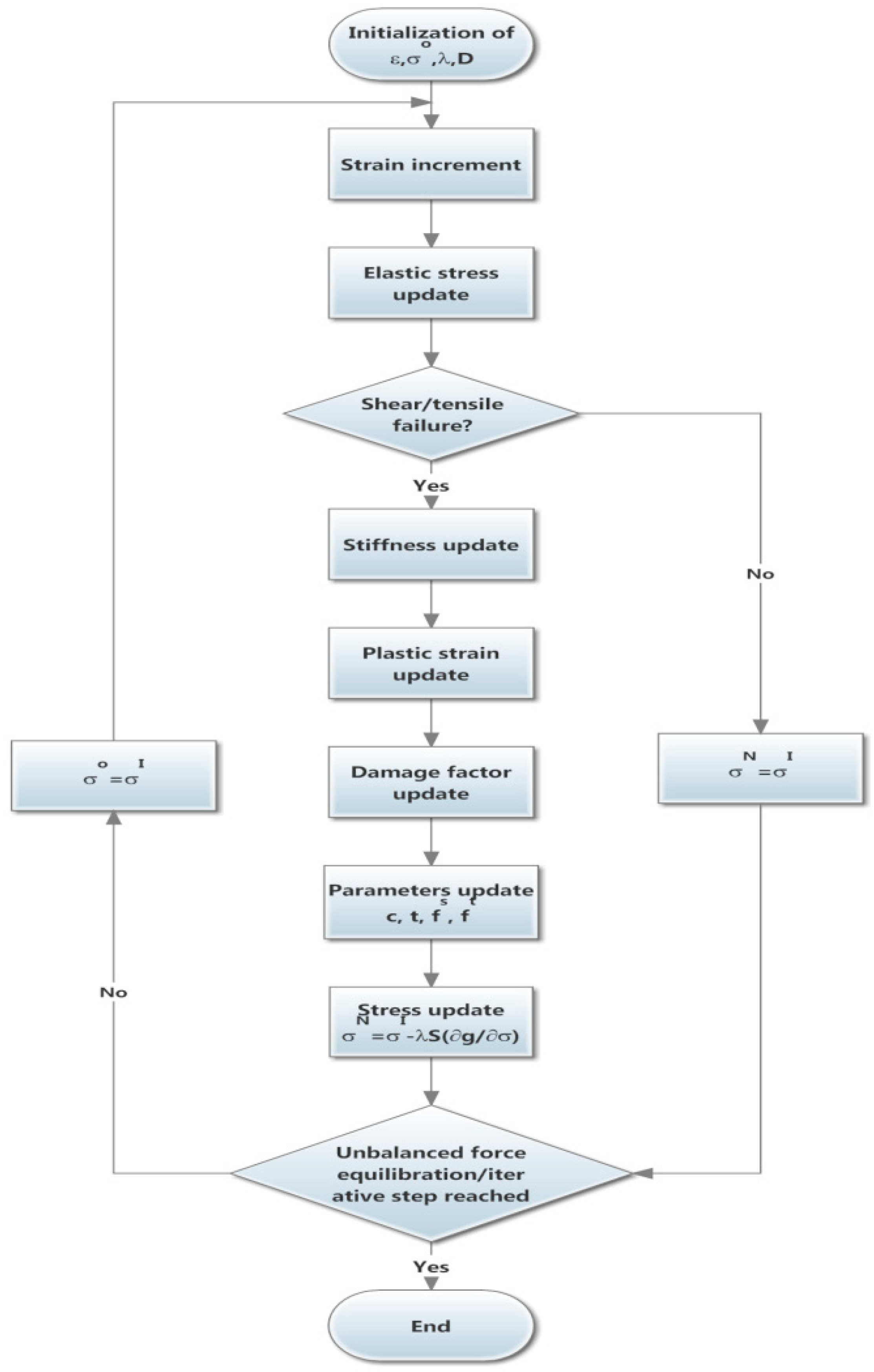
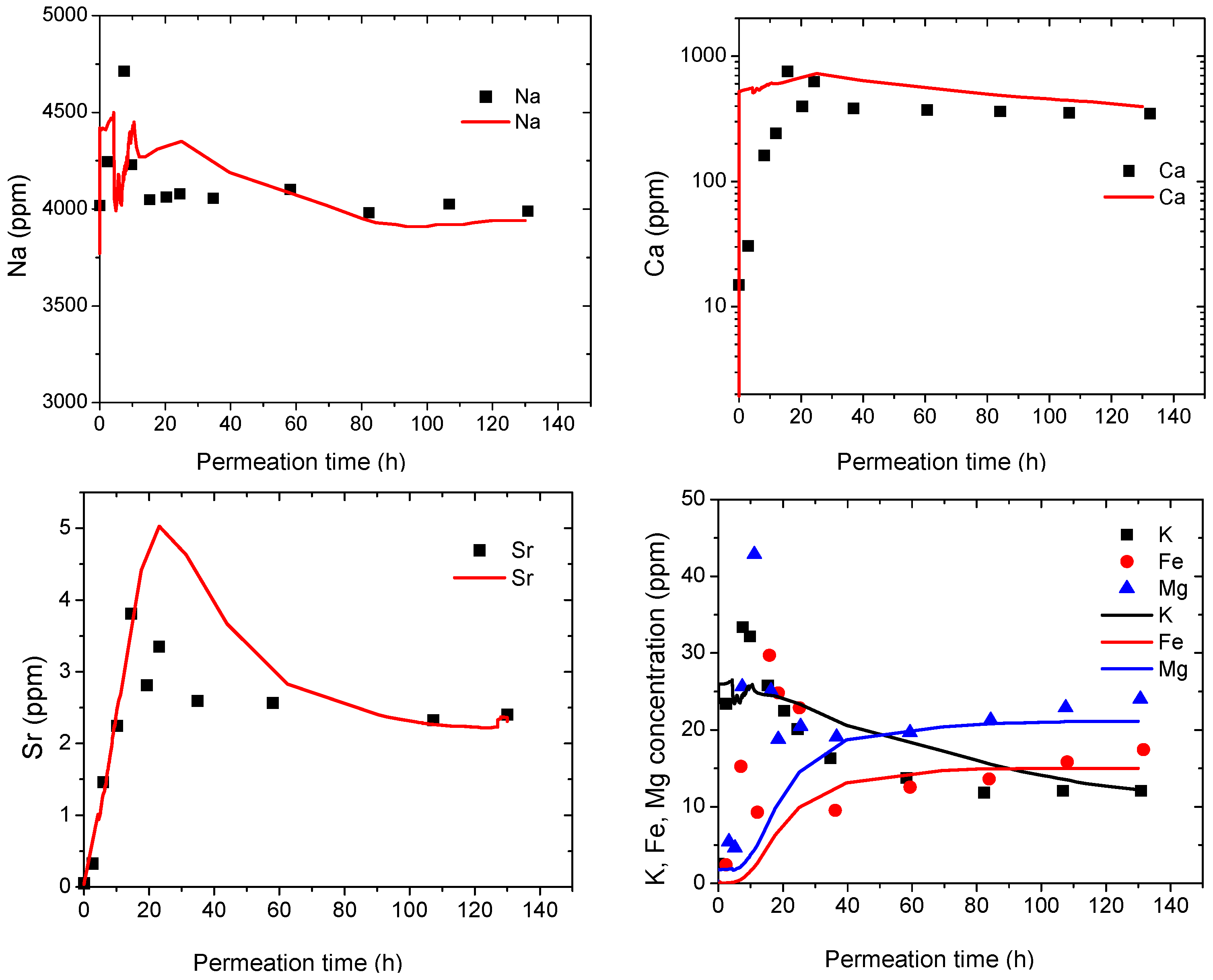
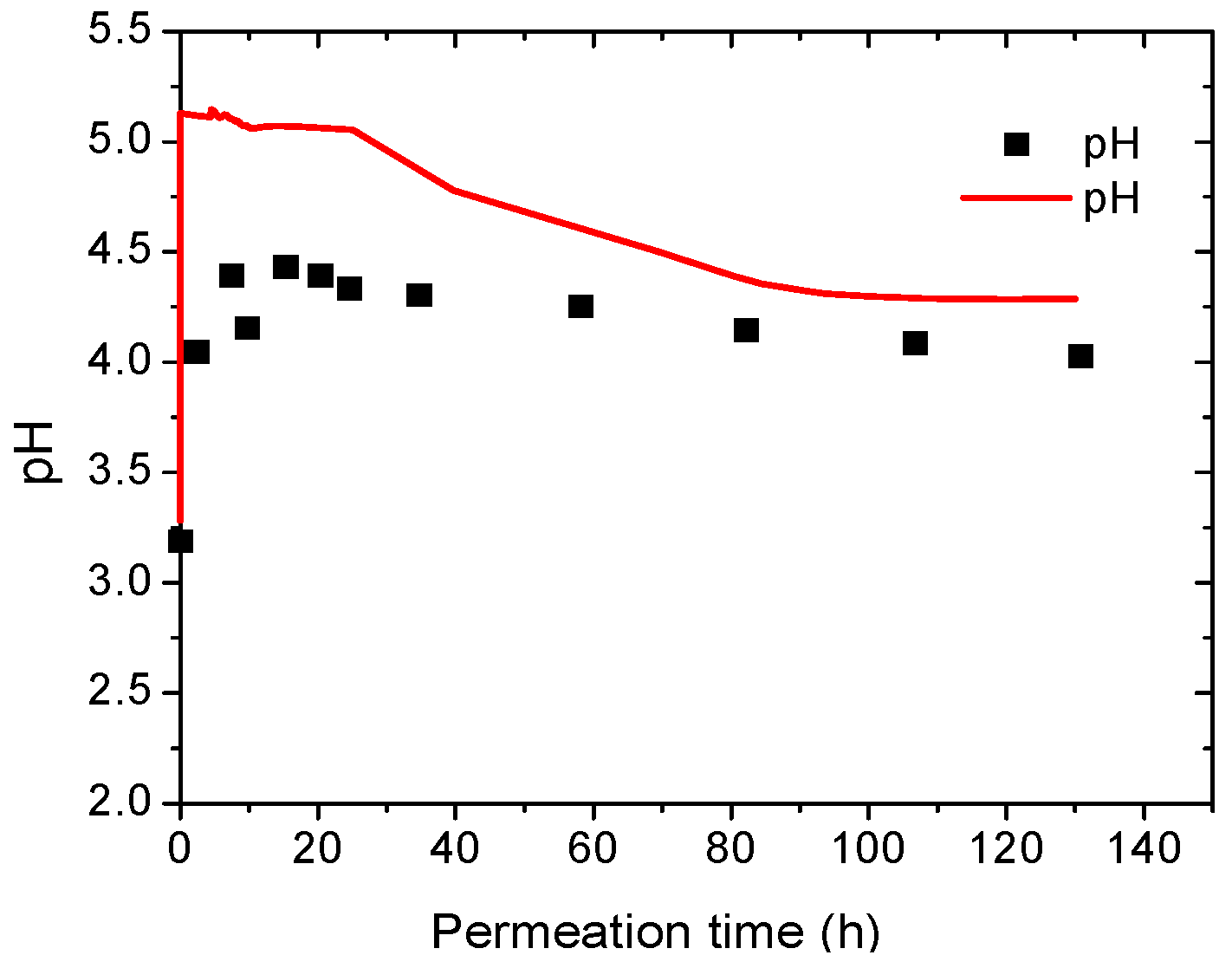
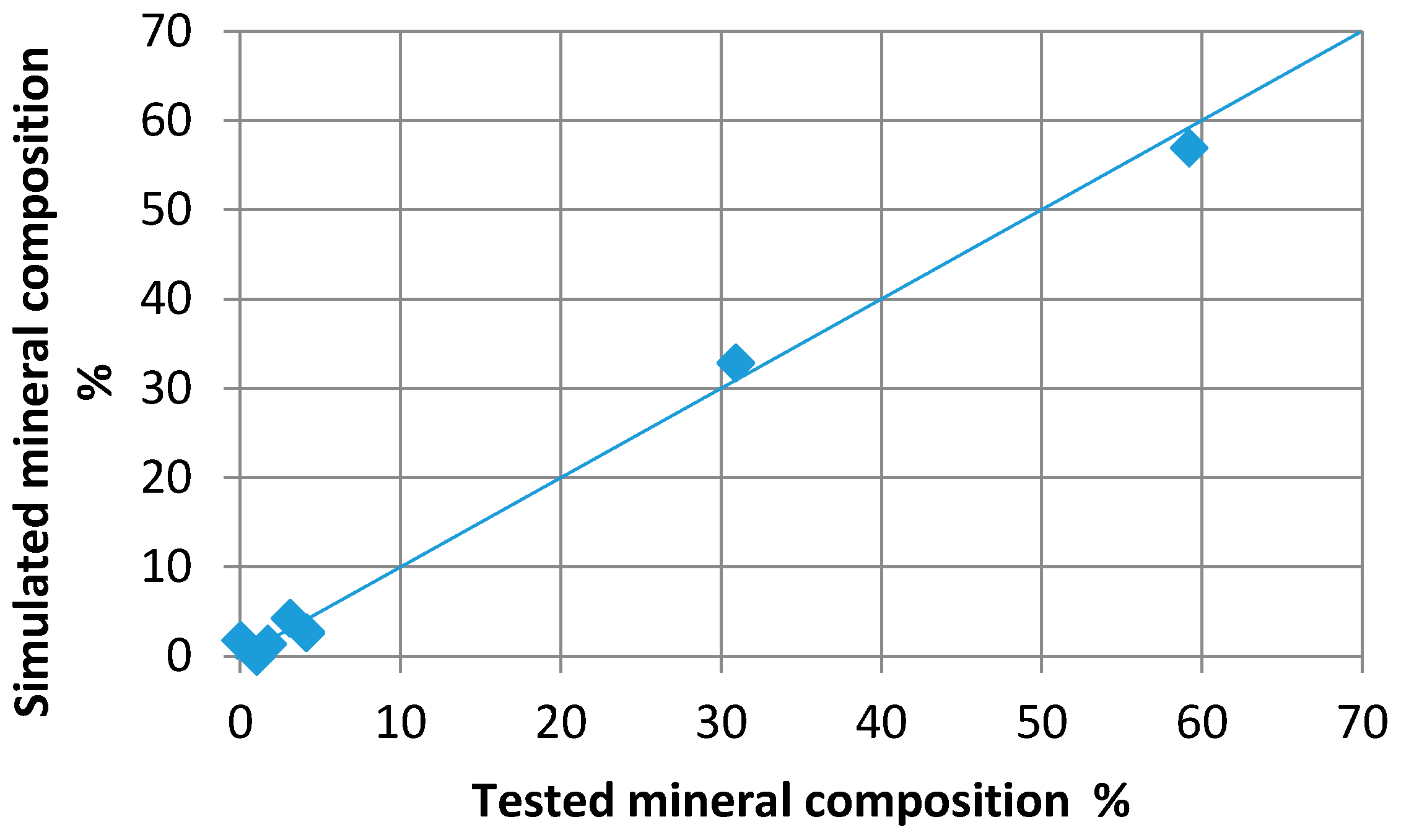
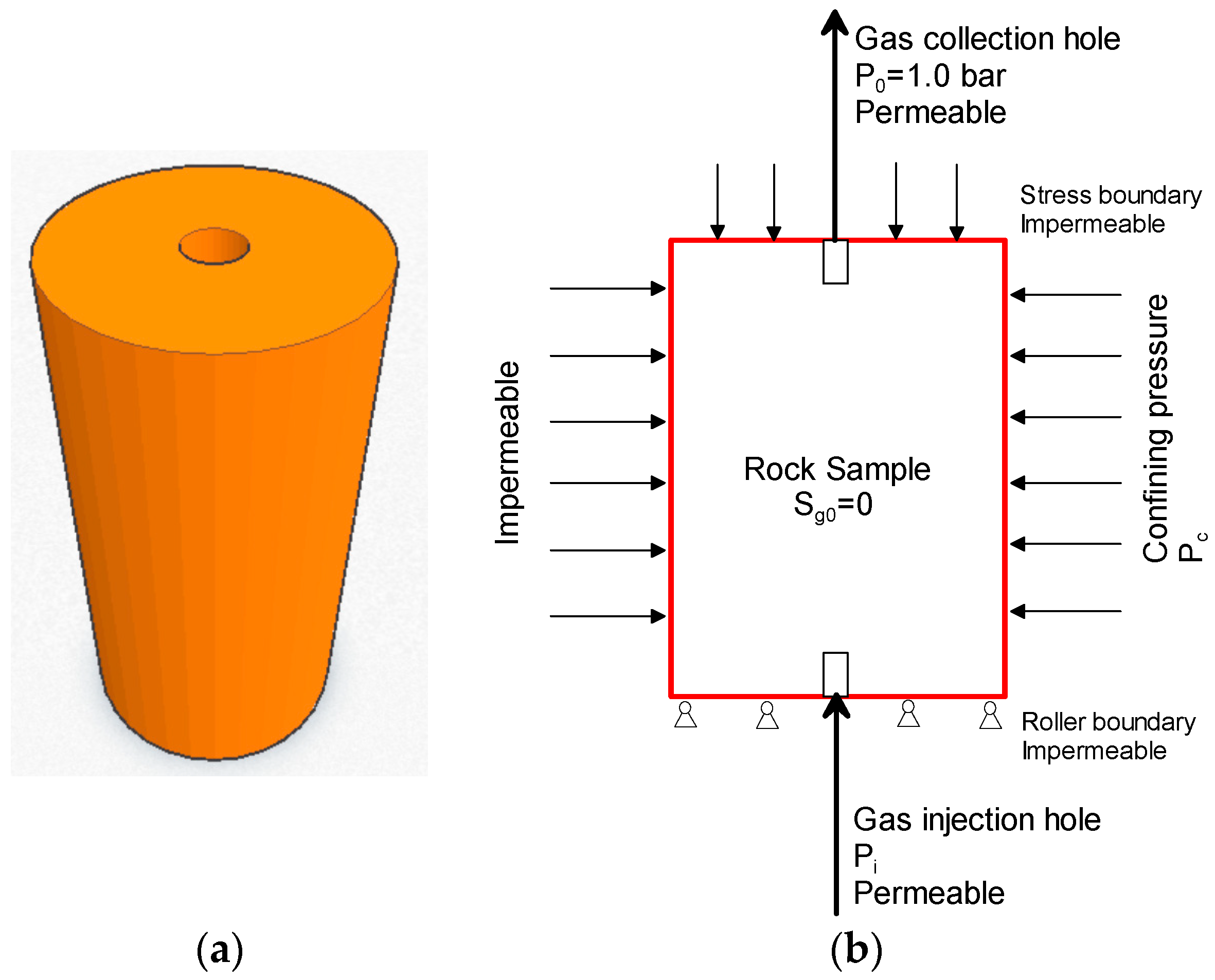
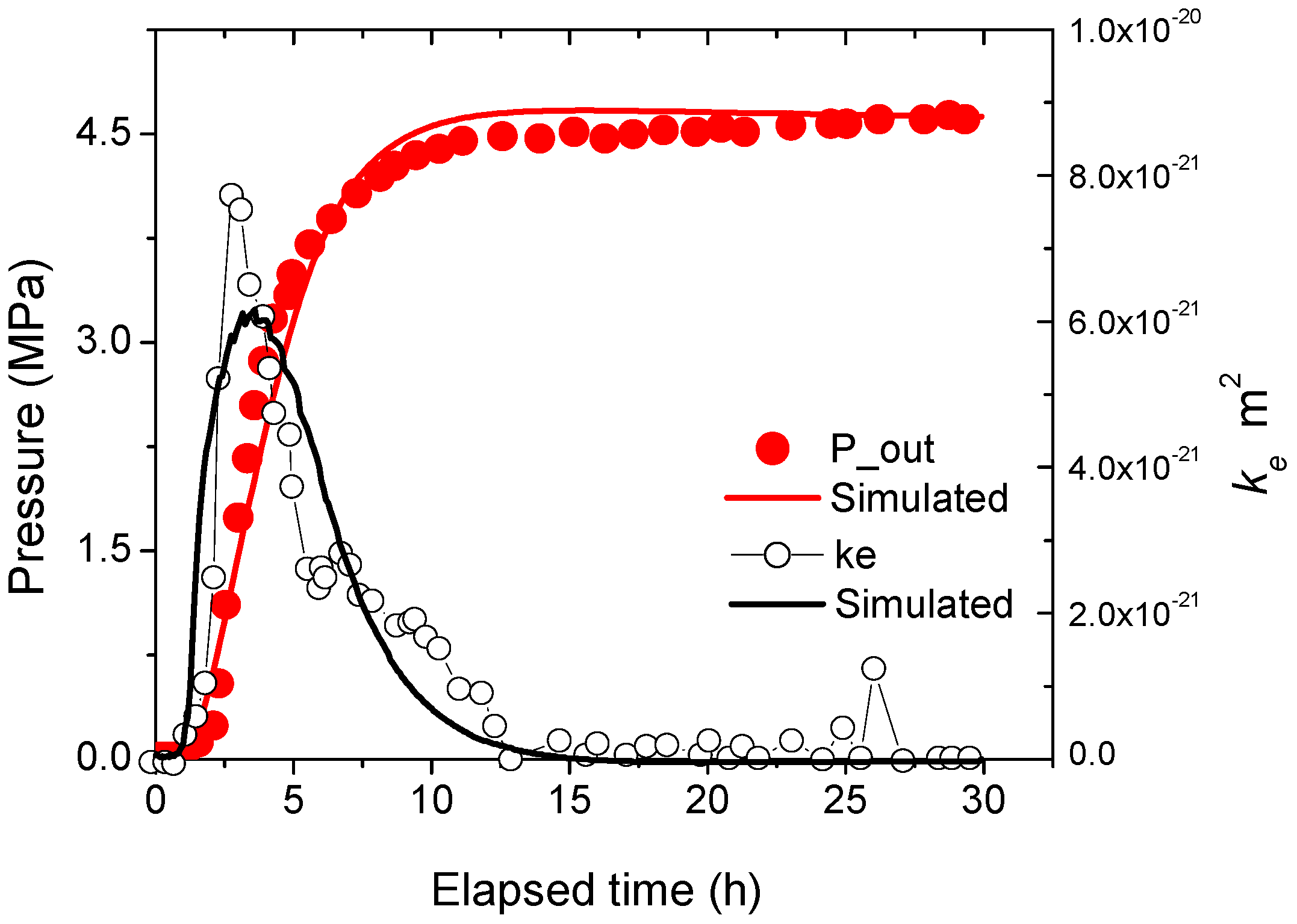
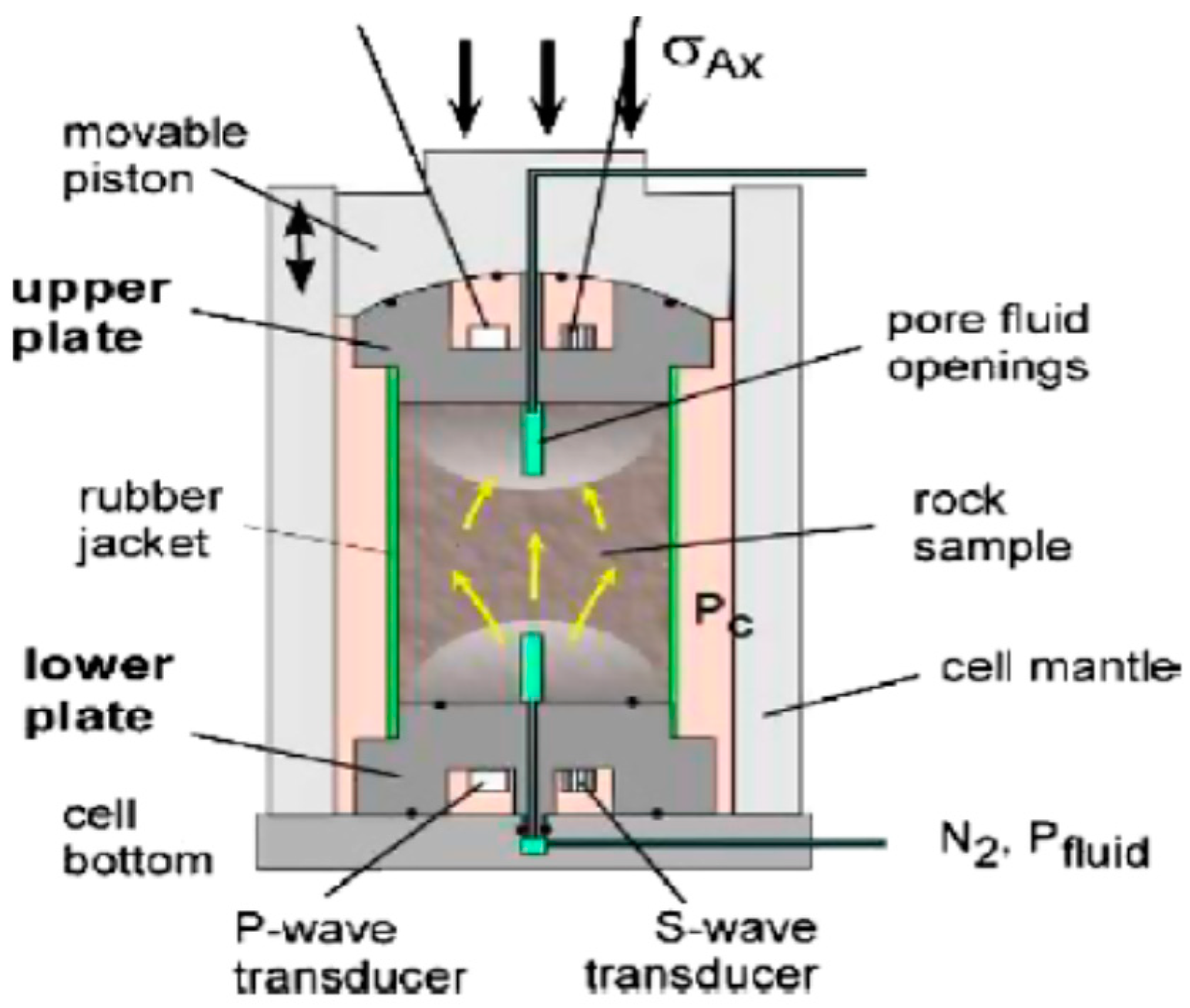
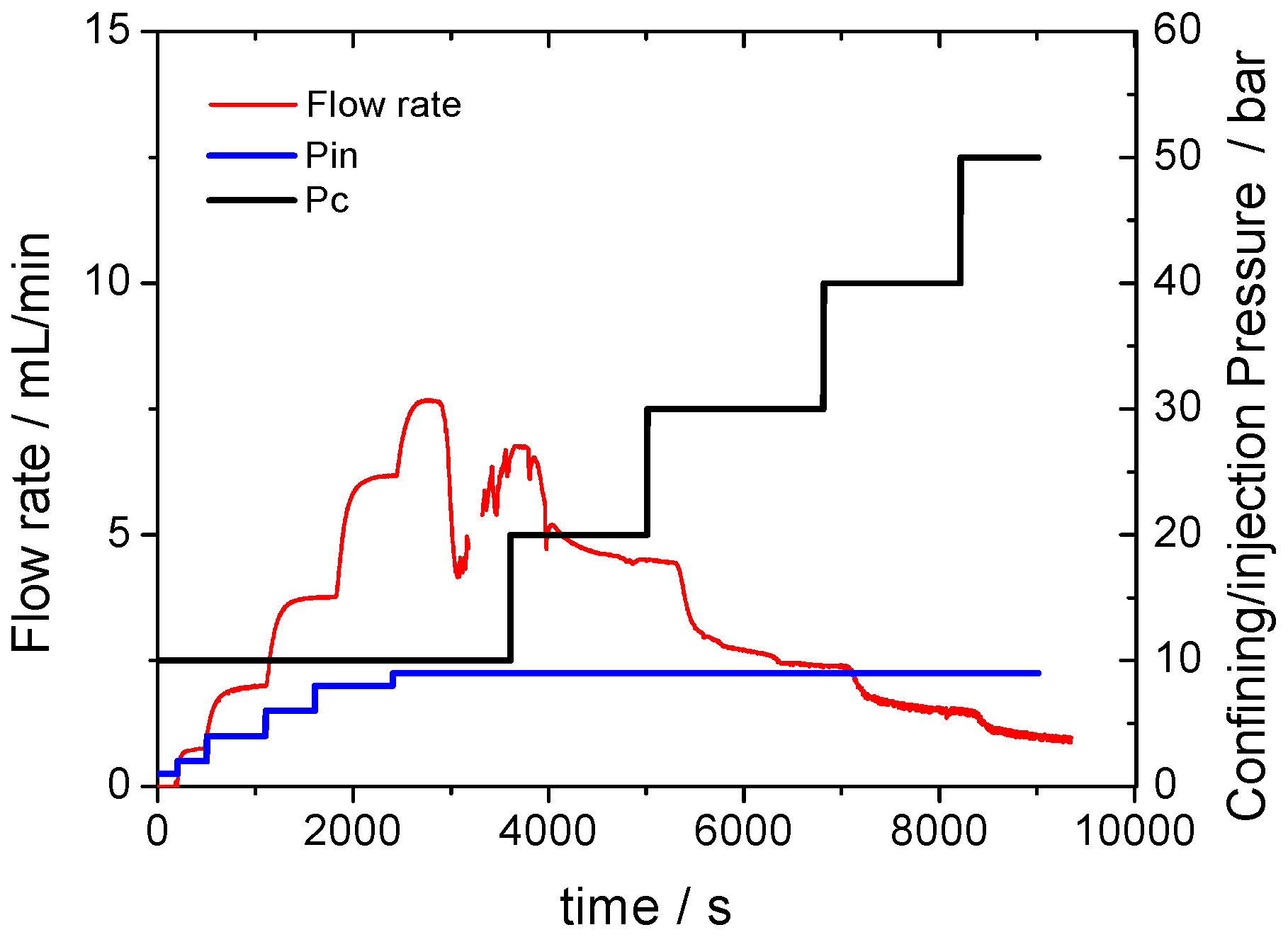

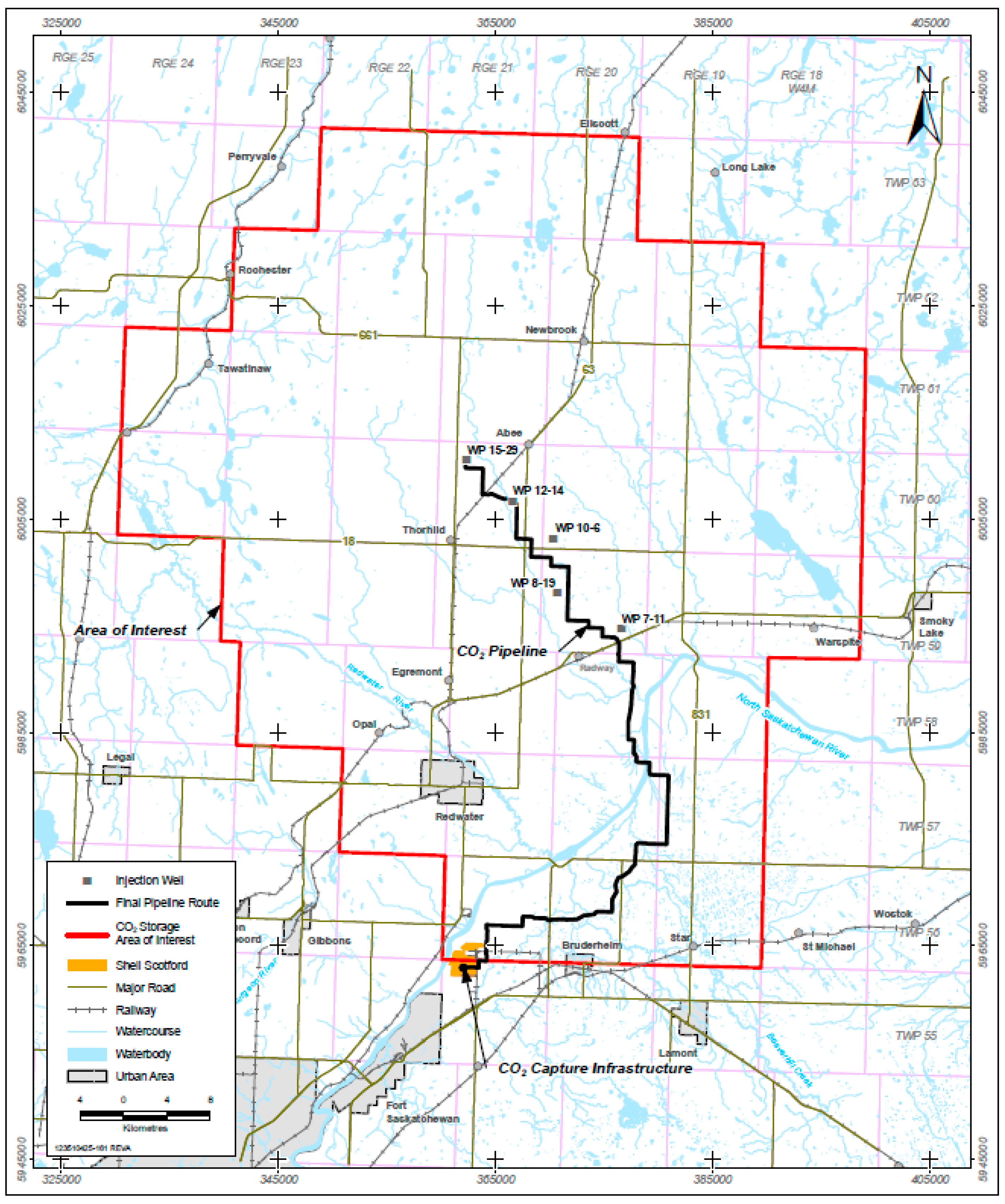



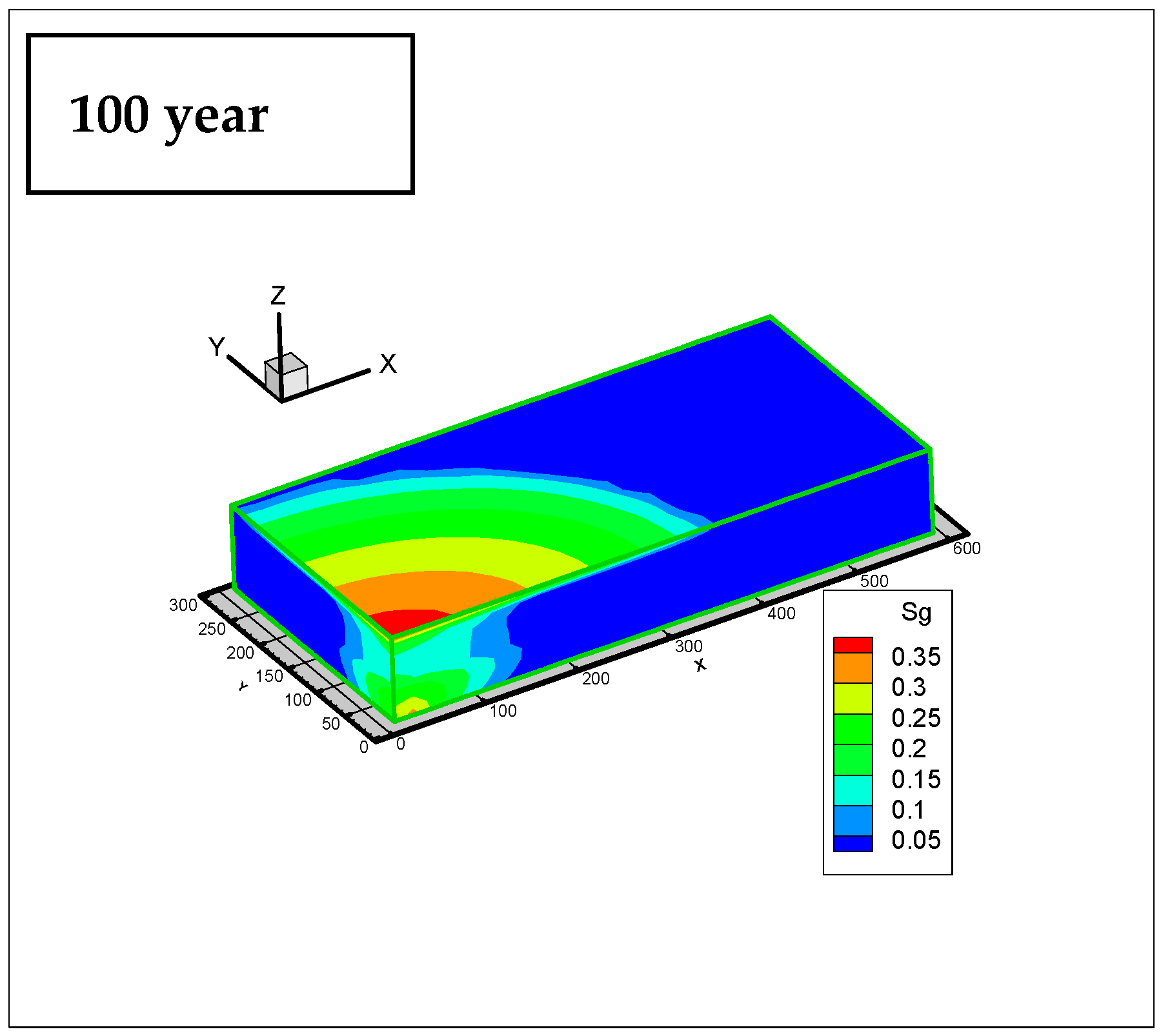

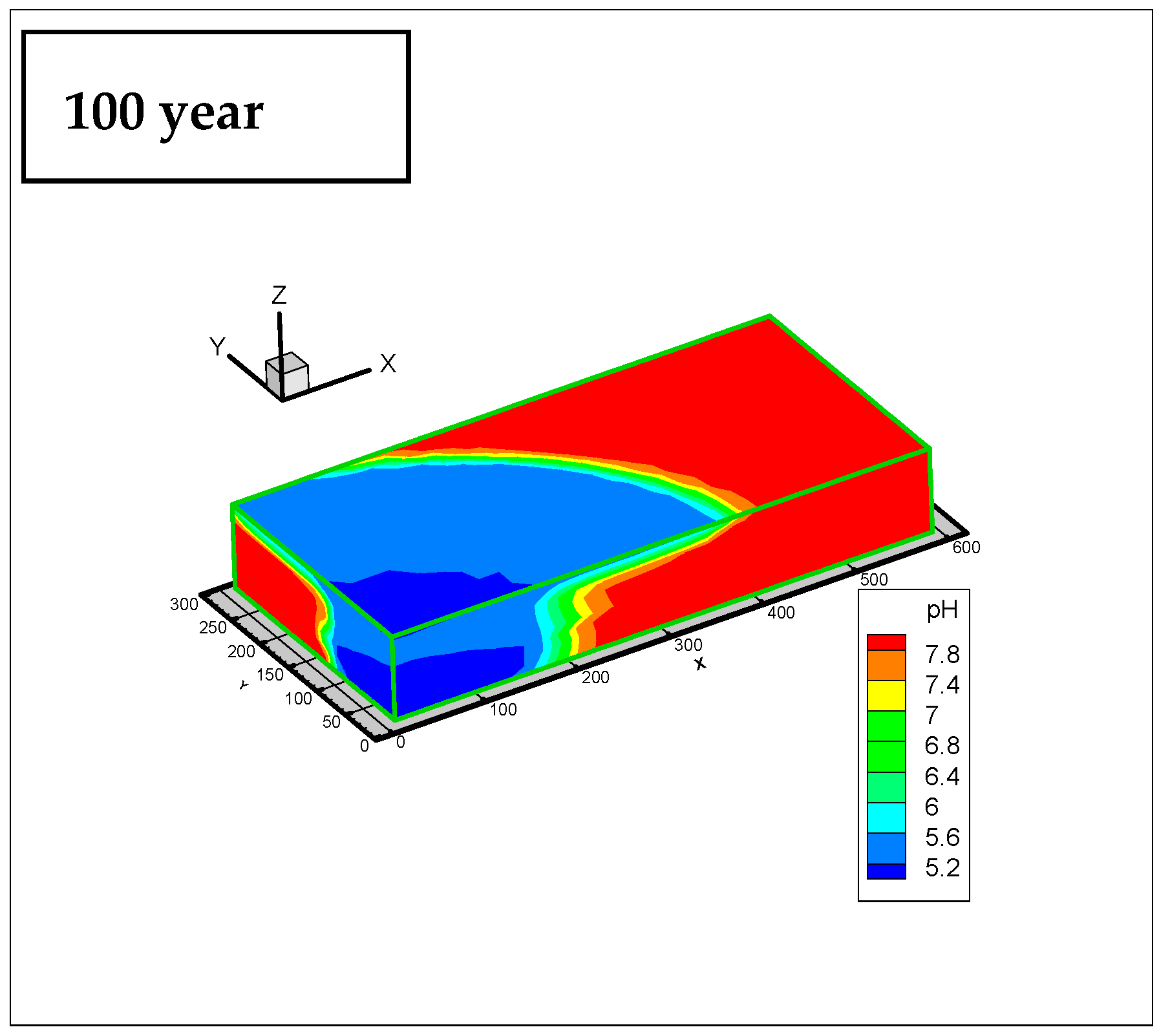
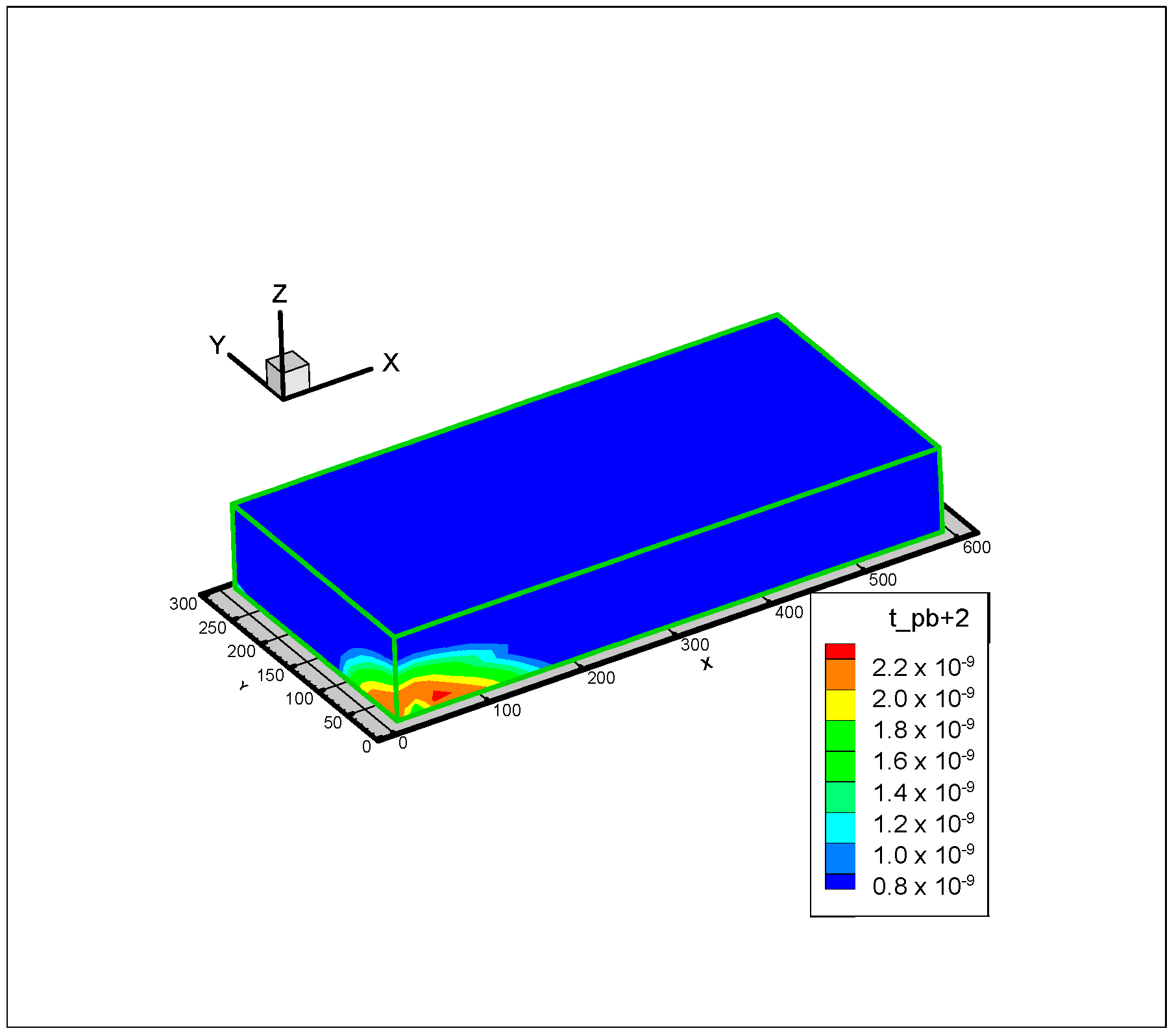
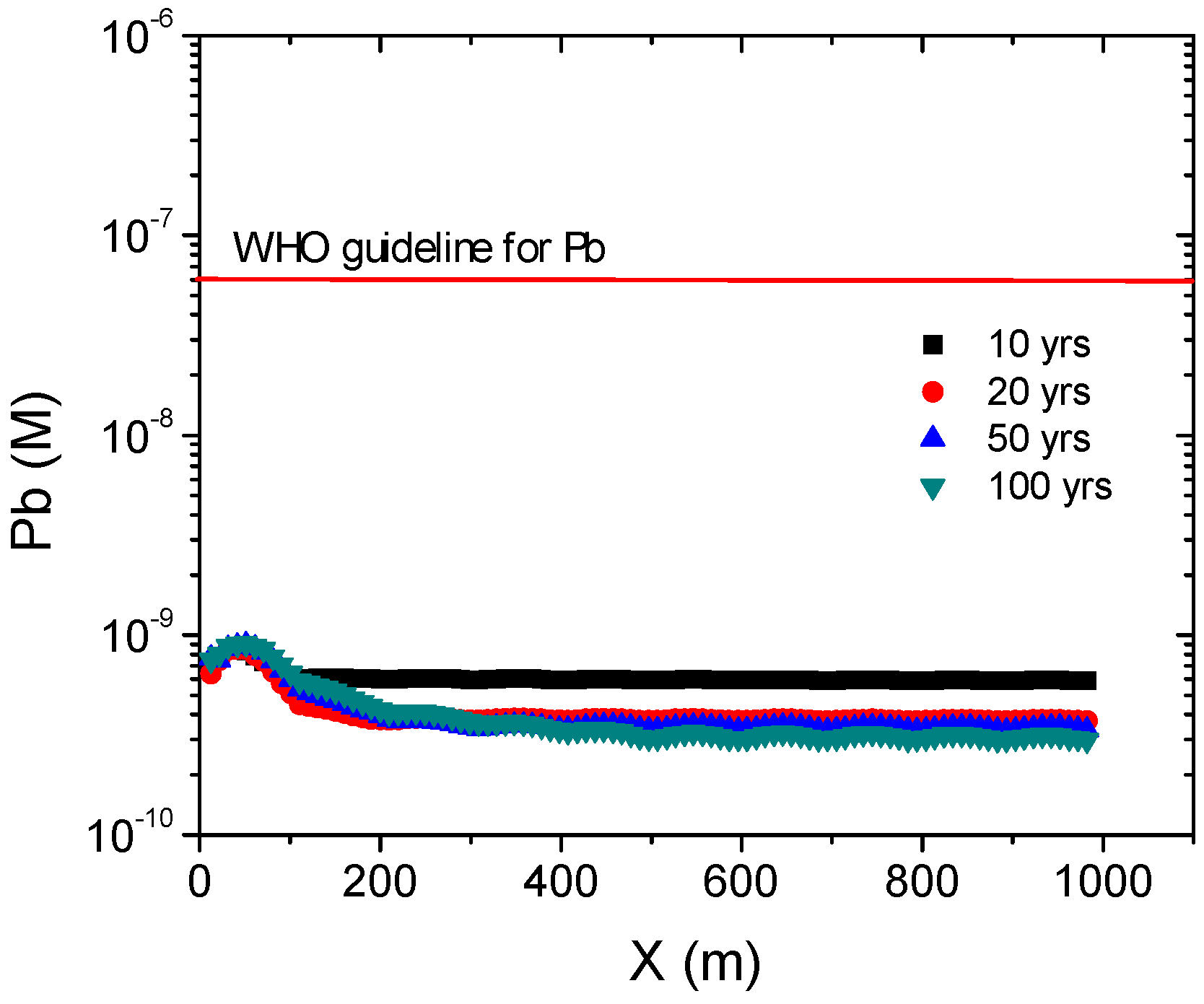
| Parameter | WHO (mg/L) | EU (mg/L) | EPA—United States (mg/L) | NHMRC (mg/L) |
|---|---|---|---|---|
| Aluminum (Al) | 0.2 | 0.2 | - | 0.1 |
| Arsenic (As) | 0.01 | 0.01 | 0.01 | 0.01 |
| Antimony (Sb) | 0.005 | 0.005 | 0.006 | 0.003 |
| Barium (Ba) | 0.7 | - | 2 | 2 |
| Benzene (C6H6) | 0.01 | 0.001 | 0.005 | 0.001 |
| Boron (B) | 2.4 | 1 | - | 4 |
| Cadmium (Cd) | 0.003 | 0.005 | 0.005 | 0.002 |
| Chromium (Cr) | 0.05 | 0.05 | 0.0001 | 0.05 |
| Chlorine (Cl) | 5 | - | - | 5 |
| Copper (Cu) | 2 | 2 | 1.3 | 2 |
| Cyanide (CN−) | 0.005 | 0.05 | 0.2 | 0.08 |
| Fluoride (F) | 1.5 | 1.5 | 4 | 1.5 |
| Lead (Pb) | 0.01 | 0.001 | 0.015 | 0.01 |
| Manganese (Mn) | 0.4 | 0.05 | 0.05 | 0.5 |
| Mercury (Hg) | 0.006 | 0.001 | 0.002 | 0.001 |
| Molybdenum (Mo) | 0.07 | - | - | 0.05 |
| Nickel (Ni) | 0.07 | 0.02 | - | 0.02 |
| Nitrate (NO3−) | 50 | 50 | 10 | 50 |
| Nitrite (NO2−) | - | 0.2 | 1 | 3 |
| Polycyclic aromatic hydrocarbons (PAHs) | - | 0.0001 | - | 0.00001 |
| Selenium (Se) | 0.04 | 0.01 | 0.05 | 0.01 |
| Silicon (Si) | - | - | - | 80 |
| Sodium (Na) | 50 | 200 | - | - |
| Uranium (U) | 0.03 | - | - | 0.017 |
| Parameter | Aluminum | Ammonia | Arsenic | Barium | Boron | Calcium | Chlorate/Chlorite | Chloride | Copper | |
|---|---|---|---|---|---|---|---|---|---|---|
| (Al) | (NH3) | (As) | (Ba) | (B) | (Ca) | (Cl) | (Cu) | |||
| MAC (mg/L) | 0.1 | None required | 0.01 | 1.0 | 5.0 | None required | 1.0 | 250 | 1.0 | |
| Parameter | Chromium | Copper | Cyanide | Fluoride | Iron | Lead | Manganese | Magnesium | Mercury | |
| (Cr) | (Cu) | (CN−) | (F) | (Fe) | (Pb) | (Mn) | (Mg) | (Hg) | ||
| MAC (mg/L) | 0.05 | 1 | 0.2 | 1.5 | 0.3 | 0.01 | 0.05 | None required | 0.001 | |
| Parameter | Nitrate | pH | Selenium | Sodium | Strontium | Sulphate | Sulphide | TDS | Uranium | Zinc |
| (NO3) | (Se) | (Na) | (Sr) | (SO2−4) | (H2S) | (U) | (Z) | |||
| MAC (mg/L) | 45 | 6.5–8.5 ** | 0.01 | 200 | 5 | 500 | 0.05 | 500 | 0.02 | 5 |
| Formations | Dinosaur Park | Oldman |
|---|---|---|
| Density (1000 kg/m3) | 2.5 | 2.5 |
| Porosity | 0.20 | 0.15 |
| Permeability—horizontal (m2) | 2.0 × 10−14 | 5.0 × 10−15 |
| Permeability—vertical (m2) | 2.0 × 10−15 | 5.0 × 10−16 |
| Pore compressibility | 1.0 × 10−8 | 1.0 × 10−8 |
| Air-entry value (Pa) | 6.80 × 104 | 1.10 × 105 |
| Mineral | Volume Percentage | ||
|---|---|---|---|
| Dinosaur Park a | Oldman a | Average b | |
| Calcite | 0.017 | 0.066 | 0.19 |
| Galena | - | - | 0.0005 c |
| Hydrocerussite | - | - | <5.0 × 10−12 |
| Quartz | 0.263 | 0.406 | 0.3 |
| K-feldspar | 0.01 | 0.02 | 0.2 |
| Kaolinite | - | - | 0.16 d |
| Smectite-ca | - | - | 0.1 d |
| Illite | - | - | 0.05 d |
| Parameter | Value | Unit | |
|---|---|---|---|
| Belly River Formation | Alberta Basin | ||
| pH | 6.9–8.95 | 8.2 | |
| EC | 9.420 | 1.22 | mS/cm |
| Eh | -66.5 | 36 | mV |
| T | 15.5 | 6.9 | °C |
| DO | 0.85 | 0.39 | mg/L |
| T-Alkalinity | 162 | 545 | mg/L |
| Boron | 1.38 | 0.26 | mg/L |
| K | 21 | 1.4 | mg/L |
| Fe | <0.1 | 0.05 | mg/L |
| Strontium | 1.17 | - | mg/L |
| OH | <5 | - | mg/L |
| CO32− | 138 | - | mg/L |
| NO3− | <0.1 | 0.002 | mg/L |
| NO2− | <0.05 | - | mg/L |
| Na | 2000 | 318 | mg/L |
| Cl− | 3050 | 10.0 | mg/L |
| Mg | <1 | 0.9 | mg/L |
| SiO32− | 5.9 | - | mg/L |
| Ca | 3 | 4.5 | mg/L |
| HCO3− | 92 | 635 | mg/L |
| Si | 12.9 | 3.75 | mg/L |
| SO42− | 20 | 93.8 | mg/L |
| As | 25 | 0.3 | ppb |
| Pb | 0.43 | 0.1 | ppb |
© 2018 by the authors. Licensee MDPI, Basel, Switzerland. This article is an open access article distributed under the terms and conditions of the Creative Commons Attribution (CC BY) license (http://creativecommons.org/licenses/by/4.0/).
Share and Cite
Li, Z.; Fall, M.; Ghirian, A. CCS Risk Assessment: Groundwater Contamination Caused by CO2. Geosciences 2018, 8, 397. https://doi.org/10.3390/geosciences8110397
Li Z, Fall M, Ghirian A. CCS Risk Assessment: Groundwater Contamination Caused by CO2. Geosciences. 2018; 8(11):397. https://doi.org/10.3390/geosciences8110397
Chicago/Turabian StyleLi, Zhenze, Mamadou Fall, and Alireza Ghirian. 2018. "CCS Risk Assessment: Groundwater Contamination Caused by CO2" Geosciences 8, no. 11: 397. https://doi.org/10.3390/geosciences8110397





